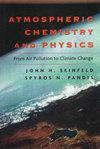Global scenarios of anthropogenic mercury emissions
IF 5.2
1区 地球科学
Q1 ENVIRONMENTAL SCIENCES
引用次数: 0
Abstract
Abstract. Anthropogenic mercury (Hg) emissions to the atmosphere are a long-lived hazard to human and environmental health. The UN Minamata Convention on Mercury is seeking to lower anthropogenic mercury emissions through a mix of policies from banning Hg uses and trade, to reducing unintentional Hg releases from different activities. In addition to independent Hg policy, greenhouse gas, particulate matter (PM) and SO2 reduction policies may also lower Hg emissions as a co-benefit. This study uses the Greenhouse Gas – Air Pollution Interactions and Synergies (GAINS) model to examine the effect of different clean air and climate policy on future global Hg emissions. The Baseline scenario assumes current energy use and Hg emissions, as well as current legislation for clean air, mercury and climate policy. In addition, we explore the impact of the Minamata Convention, co-benefits of climate policies and of stringent air pollution policies, as well as a maximum feasible reduction scenario for Hg (Hg-MFR). Hg emission projections until 2050 show noticeable reductions in combustion sectors for all scenarios, due to a decrease in global fossil fuels and traditional biomass use, leading to emission reductions of 33 % (Baseline) up to 90 % when combining stringent climate and Hg-MFR. Cement and non-ferrous metal emissions increase in all activity scenarios with current air pollution policy, but can be reduced by up to 72 % and 46 % respectively in 2050 with stringent Hg-specific measures. Other emissions (including waste) are a large source of uncertainty in this study, and projections range between a 22 % increase and 54 % decrease in 2050 depending on both climate and clean air policy. The largest absolute reduction potential for Hg abatement, but also the largest uncertainties of absolute emissions lie in the in small-scale and artisanal gold production, where Hg-specific abatement measures could eliminate annual Hg emissions in the range of 601–1371 t (95 % confidence interval). 90 % of the Hg emissions in GAINS are covered by the Minamata Convention. Overall, the findings emphasize the necessity of implementing targeted Hg control policies in addition to stringent climate, PM and SO2 policies to achieve significant reductions in Hg emissions.全球人为汞排放情景
摘要人为排放到大气中的汞(Hg)是对人类和环境健康的长期危害。联合国《汞问题水俣公约》正寻求通过一系列政策来减少人为汞排放,包括禁止汞的使用和贸易,以及减少不同活动中无意排放的汞。除独立的汞政策外,温室气体、颗粒物(PM)和二氧化硫减排政策也可降低汞排放,带来共同效益。本研究使用温室气体-空气污染相互作用与协同作用(GAINS)模型,研究不同的清洁空气和气候政策对未来全球汞排放的影响。基准情景假定了当前的能源使用和汞排放情况,以及当前的清洁空气立法、汞政策和气候政策。此外,我们还探讨了《水俣公约》、气候政策的共同效益、严格的空气污染政策以及最大可行汞减排方案(Hg-MFR)的影响。2050 年前的汞排放预测显示,由于全球化石燃料和传统生物质使用的减少,所有情景下燃烧部门的汞排放都有明显减少,在严格的气候政策和汞-MFR 政策的共同作用下,汞排放减少了 33%(基准线),达到 90%。在当前空气污染政策下,水泥和有色金属的排放量在所有活动情景中都会增加,但如果采取严格的汞减排措施,到 2050 年可分别减少 72% 和 46%。其他排放(包括废弃物)是本研究中一个很大的不确定性来源,根据气候和清洁空气政策的不同,2050 年的预测值在增加 22% 和减少 54% 之间。汞减排的绝对减排潜力最大,但绝对排放量的不确定性也最大的领域是小规模和个体黄金生产,在这一领域,针对汞的减排措施可消除 601-1371 吨(95% 置信区间)的汞年排放量。水俣公约》涵盖了性别问题信息和联网系统中 90% 的汞排放。总之,研究结果表明,除了实施严格的气候、可吸入颗粒物和二氧化硫政策外,还必须实施有针对性的汞控制政策,以大幅减少汞排放。
本文章由计算机程序翻译,如有差异,请以英文原文为准。
求助全文
约1分钟内获得全文
求助全文
来源期刊

Atmospheric Chemistry and Physics
地学-气象与大气科学
CiteScore
10.70
自引率
20.60%
发文量
702
审稿时长
6 months
期刊介绍:
Atmospheric Chemistry and Physics (ACP) is a not-for-profit international scientific journal dedicated to the publication and public discussion of high-quality studies investigating the Earth''s atmosphere and the underlying chemical and physical processes. It covers the altitude range from the land and ocean surface up to the turbopause, including the troposphere, stratosphere, and mesosphere.
The main subject areas comprise atmospheric modelling, field measurements, remote sensing, and laboratory studies of gases, aerosols, clouds and precipitation, isotopes, radiation, dynamics, biosphere interactions, and hydrosphere interactions. The journal scope is focused on studies with general implications for atmospheric science rather than investigations that are primarily of local or technical interest.
 求助内容:
求助内容: 应助结果提醒方式:
应助结果提醒方式:


